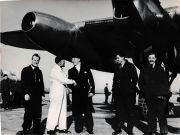Avro: Lancastrian








Type
- Passenger and mail transport airliner.
Design
- Developed from Avro Lancaster. Designed by Roy Chadwick.
Manufacturers
Number produced[1]
- 91 (including conversions)
Engines
- See variants.
The Avro 691 Lancastrian was a Canadian and British passenger and mail transport aircraft of the 1940s and 1950s developed from the Avro Lancaster heavy bomber. The Lancaster was named after Lancaster, Lancashire; a Lancastrian is an inhabitant of Lancashire.
The Lancastrian was basically a modified Lancaster bomber without armour or armament and with the gun turrets replaced by streamlined metal fairings, including a new nose section. The initial batch was converted directly from Lancasters; later batches were new builds.
In 1945, deliveries commenced of 30 British-built Lancastrians for BOAC. On a demonstration flight on 23 April 1945, G-AGLF flew 13,500 mi (21,700 km) from England to Auckland, New Zealand in three days, 14 hours at an average speed of 220 mph (354 km/h).
The Lancastrian was fast, had a long range, and was capable of carrying a heavy load, but space inside was very limited as the Lancaster had been designed with space for its seven crew dispersed throughout the fuselage, and the 33 ft (10.05 m) long bomb bay. Consequently, it was not suited to carry large numbers of passengers, but was suitable for mail and a small number of VIP passengers. BOAC used it for flights between England and Australia from 31 May 1945. It also served with the RAF; RAF Lancaster I serial number PD328, was converted to a Lancastrian and renamed Aries, as well as serving with QANTAS and Flota Aérea Mercante Argentina.[2]
Nene-Lancastrian (VH742) - Flew the first international all-jet passenger flight from London to Le Bourget, Paris on 18th November 1946 en route for Villacoublay. The journey took 50 minutes.[3]
On 2 August 1947 Lancastrian G-AGWH Star Dust of British South American Airways was lost in the Argentine Andes, whilst en route from Buenos Aires, Argentina, to Santiago, Chile. The probable cause of the crash was a navigation error due to the then-unknown effect of the fast-moving jetstream.
See the article about the Stardust accident on Wikipedia here.
Variants
| Name | Serial | Test engine |
|---|---|---|
| Nene-Lancastrian | VH742 | 2x Rolls-Royce Nene + 2x Rolls-Royce Merlin |
| Nene-Lancastrian | VH737 | 2x Rolls-Royce Nene + 2x Rolls-Royce Merlin |
| Avon-Lancastrian | VM732 | 2x Rolls-Royce Avon + 2x Rolls-Royce Merlin |
| Avon-Lancastrian | VL970 | 2x Rolls-Royce Avon + 2x Rolls-Royce Merlin |
| Ghost-Lancastrian | VM703 | 2x De Havilland Ghost 50 + 2x Rolls-Royce Merlin + 2x Walter HWK 109-500 RATOG packs |
| Ghost-Lancastrian | VM729 | 2x De Havilland Ghost 50 + 2x Rolls-Royce Merlin |
| Sapphire-Lancastrian | VM733 | 2x Armstrong Siddeley Sapphire + 2x Rolls-Royce Merlin |
| Griffon-Lancastrian | VM704 | 2x Rolls-Royce Griffon 57 inboard + 2x Rolls-Royce Merlin T.24/4 outboard. |
| Griffon-Lancastrian | VM728 | 2x Rolls-Royce Griffon 57 inboard + 2x Rolls-Royce Merlin T.24/4 outboard |
| Merlin 600-Lancastrian | VM704 | 2x Rolls-Royce Merlin 600 + 2x Rolls-Royce Merlin |

